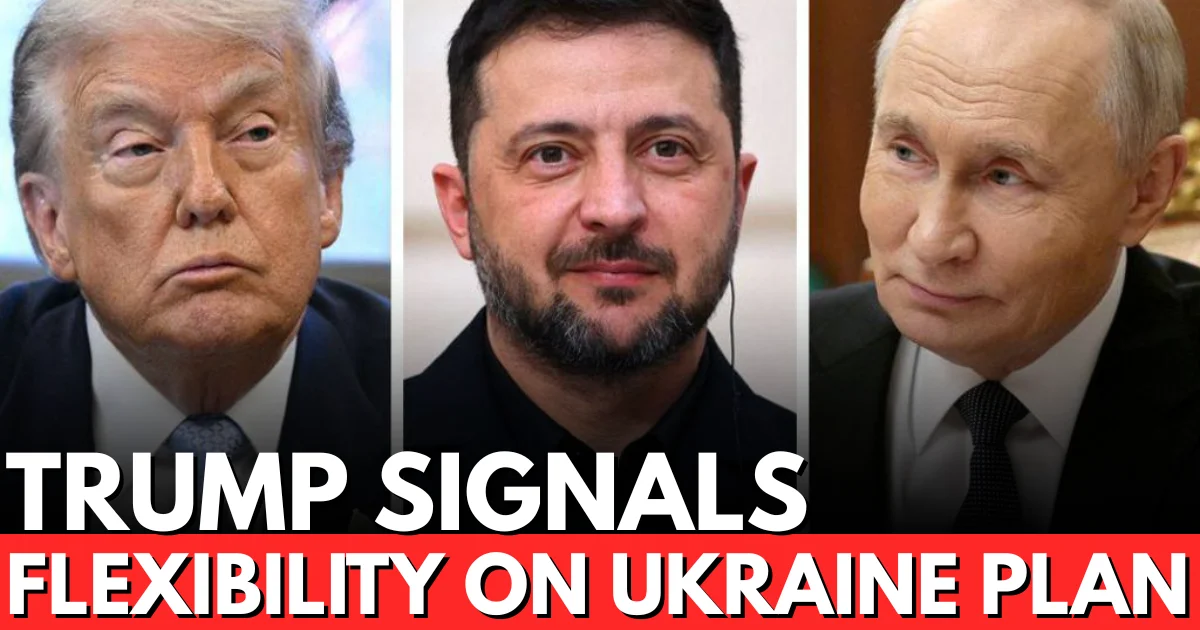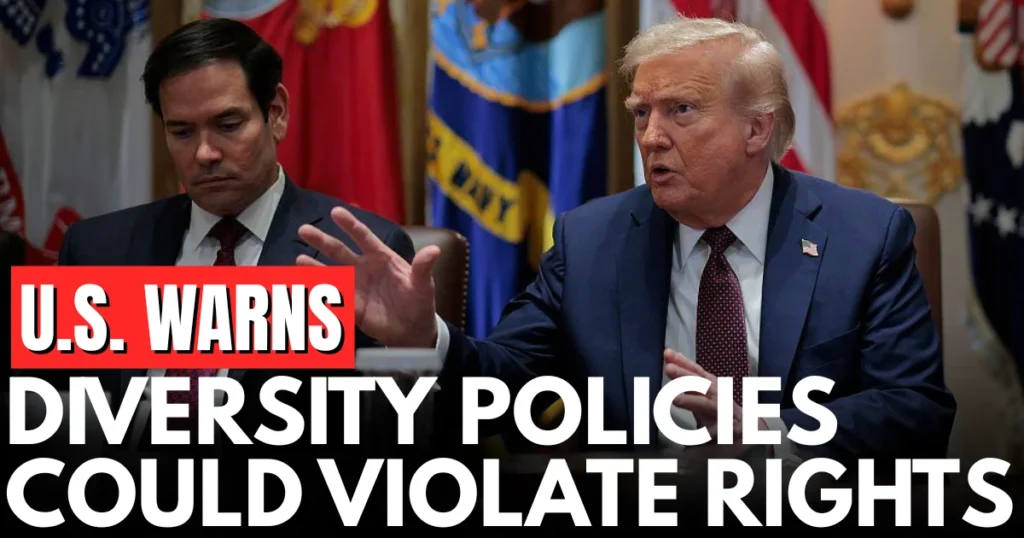Trump clarifies US Ukraine peace plan remains negotiable. Latest on diplomatic strategy, Kyiv’s response, and what this means for ending the war.
Table of Contents
Trump Clarifies US Ukraine Peace Plan Remains Flexible, Not ‘Final Offer’ to Kyiv
Introduction:
Former President Donald Trump emphasized that the United States peace proposal for ending the Ukraine conflict should not be interpreted as a final, take-it-or-leave-it ultimatum to Kyiv. His comments signal continued diplomatic flexibility as negotiations evolve in the coming weeks.
Trump’s clarification comes amid intense scrutiny of American strategy toward resolving the prolonged Eastern European conflict. The statement addresses concerns from Ukrainian officials and US allies about the negotiating framework and whether Kyiv maintains meaningful input into final settlement terms.
What Trump Actually Said About the Peace Proposal
Speaking to reporters this week, Trump addressed questions about the recently proposed peace framework that has dominated international diplomatic discussions.
“This is not a final offer. We’re working with Ukraine, we’re being very flexible,” Trump stated. “We want peace, but it has to be the right deal for everyone involved, especially for the people who have suffered so much.”
Key elements of Trump’s statement:
- Peace plan represents starting framework, not ultimatum
- Administration remains open to Ukrainian input and modifications
- Focus on achieving sustainable, lasting resolution
- Emphasis on protecting American interests while supporting allies
- Commitment to continued diplomatic engagement
The clarification appears designed to reassure Ukrainian officials concerned about being pressured into unfavorable terms. It also signals to international partners that American diplomacy prioritizes collaboration over unilateral dictates.
Political analysts note the careful balancing act Trump faces. He must demonstrate progress toward his campaign promise of quickly ending the conflict while avoiding accusations of abandoning a democratic ally.
Details of the Proposed Peace Framework
While complete specifics remain confidential for diplomatic reasons, sources familiar with the proposal have outlined general parameters under consideration.
The framework reportedly addresses security guarantees, territorial considerations, economic reconstruction, and long-term stability mechanisms. Each component requires intricate negotiation among multiple stakeholders with competing interests.
Major framework components include:
- Security Arrangements: Long-term defense commitments and verification systems
- Territorial Settlement: Phased implementation of agreed-upon arrangements
- Reconstruction Funding: Multi-billion dollar international investment programs
- NATO Considerations: Ukraine’s future relationship with Western alliance structures
- Russian Participation: Terms under which Moscow would engage in settlement
American negotiators have presented the framework as comprehensive yet adaptable. This approach aims to establish clear parameters while allowing room for refinement based on stakeholder feedback.
Financial implications remain substantial. Estimates suggest American contributions to reconstruction and security guarantees could reach $100-200 billion over the next decade, though final figures depend entirely on negotiated terms.
Ukraine’s Response to the Peace Proposal
Ukrainian officials have responded cautiously to the American peace initiative, emphasizing that Kyiv must maintain agency over decisions affecting its sovereignty and security.
President Volodymyr Zelenskyy’s administration has publicly stated that any settlement must respect Ukraine’s territorial integrity and provide concrete security guarantees preventing future aggression. These non-negotiable principles shape Ukrainian negotiating positions.
Kyiv’s stated priorities include:
- Meaningful security commitments from major Western powers
- International verification mechanisms for any agreement
- Substantial reconstruction assistance coordinated with Ukrainian authorities
- Preservation of Ukraine’s path toward European integration
- Justice and accountability for war crimes
Ukrainian diplomatic sources indicate general appreciation for American engagement while emphasizing the importance of Ukrainian voices in shaping final terms. The response to Trump’s “not final offer” clarification has been cautiously positive.
Public opinion within Ukraine remains divided on peace negotiations. Recent polling shows 58% of Ukrainians support diplomatic engagement, while 35% prefer continued military resistance until complete territorial restoration. These domestic political realities constrain Ukrainian negotiators’ flexibility.
Political Reactions in Washington
Trump’s peace initiative and subsequent clarifications have generated mixed reactions across the American political spectrum.
Republican supporters praise the diplomatic engagement as demonstrating leadership and fulfilling campaign commitments to prioritize American interests. They argue that endless conflict serves neither Ukrainian nor American strategic goals.
Congressional Republican responses:
Republican leadership in both chambers has generally supported diplomatic efforts while emphasizing the need for Congressional oversight of any financial commitments. Senate Foreign Relations Committee members have requested detailed briefings on negotiation progress.
Conservative fiscal hawks particularly appreciate potential reduction in ongoing military aid expenditures. Current assistance totals approximately $60-70 billion annually, representing a significant federal budget item.
Democratic criticism and concerns:
Democratic lawmakers have expressed skepticism about the peace framework, questioning whether it adequately protects Ukrainian sovereignty and American credibility with allies. Senior Democrats warn against any settlement perceived as rewarding aggression.
House Democrats have called for transparency regarding negotiation details and insisted on robust Congressional approval for major policy shifts. The minority party emphasizes maintaining bipartisan consensus on supporting democratic allies.
National security experts from previous administrations have offered mixed assessments. Some praise diplomatic creativity while others worry about precedents set by territorial compromises.
International Implications and Allied Perspectives
European allies are watching American diplomatic initiatives closely, given their direct security interests in Eastern European stability.
NATO members have expressed appreciation for American leadership in seeking peaceful resolution while emphasizing alliance unity. European capitals want assurance that any settlement protects collective security architecture.
Key international stakeholder positions:
- United Kingdom: Strong support for Ukrainian sovereignty in any settlement
- France and Germany: Emphasis on European security architecture integration
- Poland and Baltic States: Concerns about precedents for future Russian behavior
- European Union: Focus on reconstruction coordination and economic integration
The United Nations has offered to facilitate implementation mechanisms if parties reach agreement. International organizations stand ready to deploy verification missions and coordinate humanitarian assistance.
Russia’s position remains unclear publicly, though diplomatic sources suggest Moscow may be more willing to negotiate than previous rhetoric indicated. Economic pressures and military realities may be shifting calculations in the Kremlin.
Economic and Defense Industry Impact
Trump’s peace initiative carries significant implications for American defense contractors and the broader economy.
A negotiated settlement could reduce demand for certain weapons systems and military equipment. Defense stocks showed mixed performance following Trump’s announcement, with some sectors declining while reconstruction-related companies gained.
Economic sectors affected:
- Defense Manufacturing: Potential reduction in artillery and ammunition contracts
- Aerospace: Uncertain impact on aircraft and missile system orders
- Construction: Major opportunities in reconstruction projects
- Technology: Cybersecurity and infrastructure modernization demand
- Financial Services: Managing reconstruction funds and investment
Wall Street analysts project that peace could shift $15-25 billion annually from military production toward reconstruction activities. This transition would create winners and losers across different industry sectors.
American energy companies could benefit substantially from European energy security initiatives. Natural gas exports and renewable energy projects represent significant commercial opportunities in post-conflict scenarios.
What Happens Next in the Negotiation Process
The diplomatic roadmap ahead includes several critical milestones that will determine whether Trump’s initiative produces concrete results.
Negotiating teams from the United States, Ukraine, and potentially other stakeholders will continue intensive discussions throughout the coming weeks. Technical working groups are addressing specific implementation challenges.
Upcoming diplomatic timeline:
- Week 1-2: Congressional briefings and consultations with allies
- Week 3-4: Follow-up negotiations incorporating Ukrainian feedback
- Month 2: Potential framework refinement and broader stakeholder input
- Month 3: Possible announcement of preliminary agreement terms
- Month 4+: Implementation planning and resource allocation
Trump has indicated willingness to personally engage in negotiations if helpful. Presidential-level diplomacy could accelerate progress but also raises stakes for successful outcomes.
Public messaging will intensify as both supporters and critics make their cases. The American public’s sustained support remains crucial for Congressional approval of any significant financial commitments.
Frequently Asked Questions
Q1: What is Trump’s current peace plan for ending the Ukraine war?
Trump’s framework proposes a comprehensive settlement addressing security guarantees, territorial arrangements, reconstruction funding, and long-term stability mechanisms. He emphasizes the plan remains flexible and open to Ukrainian input, not a final ultimatum to Kyiv.
Q2: How has Ukraine responded to Trump’s peace proposal?
Ukrainian officials have responded cautiously, appreciating American diplomatic engagement while emphasizing that Kyiv must maintain decision-making authority over its sovereignty and security. Ukraine insists any settlement must include concrete security guarantees and respect territorial integrity.
Q3: How much will the US spend on Ukraine under a peace agreement?
Estimated American contributions could reach $100-200 billion over the next decade for reconstruction and security guarantees. Final costs depend entirely on negotiated terms and would require Congressional approval.
Q4: What do Congressional Democrats think about Trump’s Ukraine peace plan?
Democratic lawmakers have expressed skepticism, questioning whether the framework adequately protects Ukrainian sovereignty and American credibility with allies. They demand transparency and insist on Congressional oversight of any major policy commitments.
Q5: When could a final peace agreement be reached for Ukraine?
No definitive timeline exists. If current diplomatic momentum continues, a preliminary framework agreement could emerge within 2-3 months, with full implementation potentially spanning 12-24 months. Significant obstacles remain before finalizing any comprehensive settlement.
Conclusion: Diplomatic Flexibility Amid Complex Realities
Trump’s clarification that the American peace proposal is not a “final offer” signals important diplomatic flexibility as negotiations progress.
The coming weeks will reveal whether this framework can bridge competing interests among Ukraine, the United States, European allies, and potentially Russia. Success requires balancing Ukrainian sovereignty, American strategic interests, and realistic conflict resolution.
Trump faces the challenge of delivering on campaign promises to end the conflict quickly while avoiding accusations of abandoning democratic allies or rewarding aggression. The delicate balancing act requires skillful diplomacy and sustained domestic political support.
American voters, Congressional leaders, and international partners will all play roles in determining whether this peace initiative succeeds or joins the long list of unsuccessful conflict resolution attempts.

